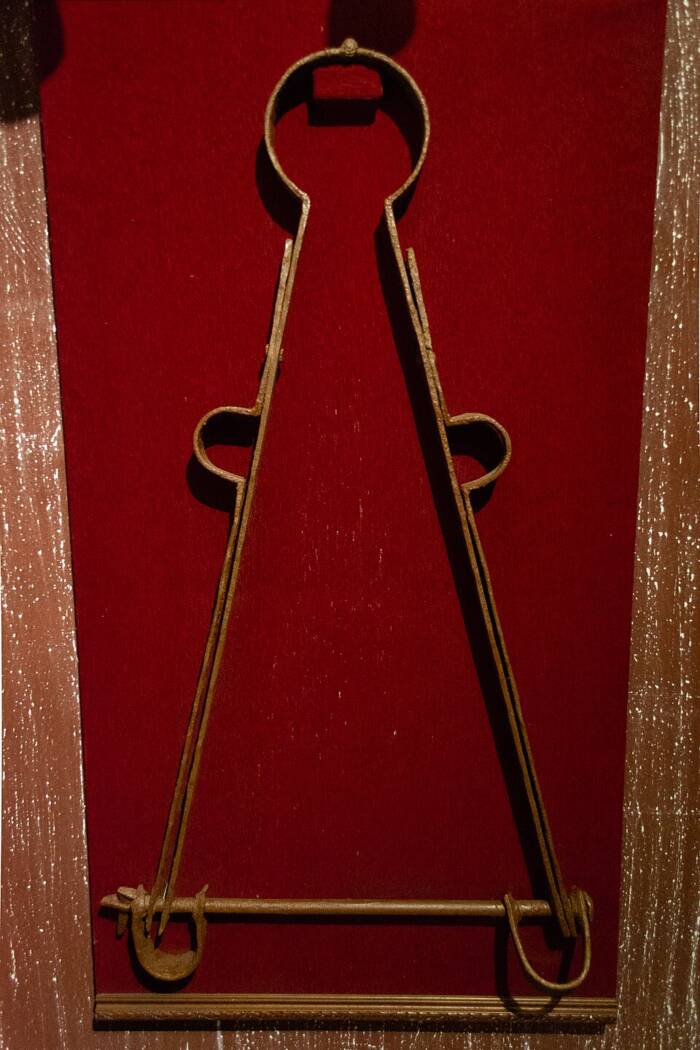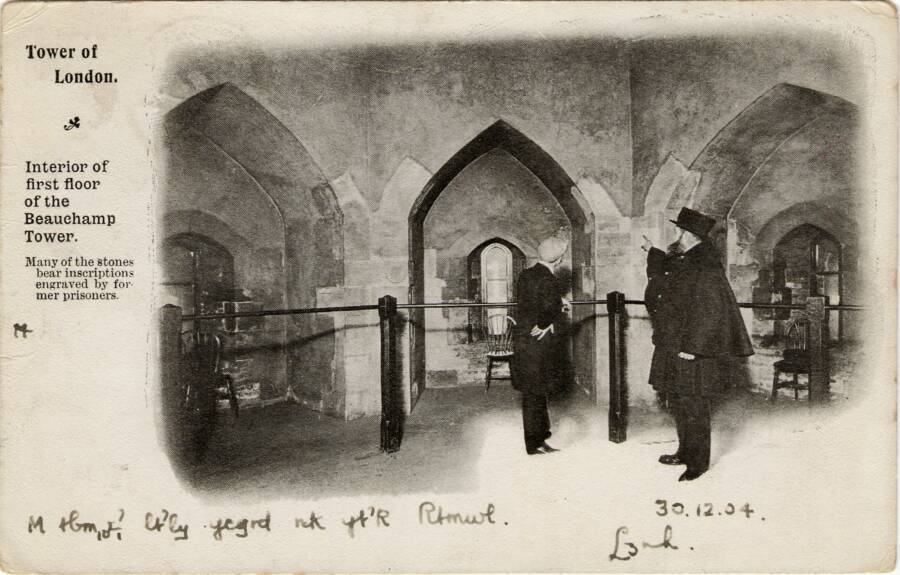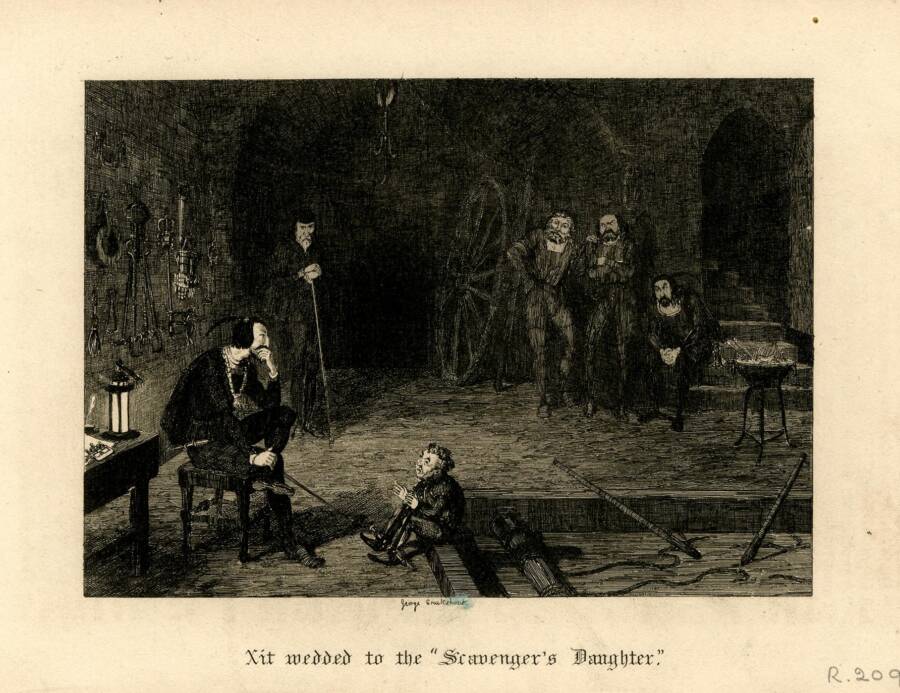Invented during the reign of England's King Henry VIII for use at the Tower of London, the scavenger's daughter was a metal device that forced its victims into a kneeling position, painfully compressing their bodies until they bled from the ears.

Dorieo/Wikimedia CommonsThe scavenger’s daughter was an excruciating torture device that painfully compressed its victims.
Scarcely anything reflects the darkest aspects of humanity more than medieval torture devices. One little-known instrument of abuse was the scavenger’s daughter, which essentially squished its victims by folding them in half. Today, the implement serves merely as a historical artifact, showcasing humanity’s bleakest engineering ingenuity at a time of extreme religious fanaticism and oppressive feudalism.
During the reign of King Henry VIII, however, the device meant nothing but misery. A metal frame shaped innocently like a capital “A,” the scavenger’s daughter was used to brutally trap subjects between its unwavering poles to crush, bend, and force accused traitors into a confession.
While the historical record contains only a few documented cases of its use, the scavenger’s daughter befell Irish rebels, priests, and more. It was used during horrific interrogations inside the Tower of London, and it has since been featured in films, television series, and books.
None have ever come close, however, to conveying the extreme pain it caused to those unlucky enough to be strapped inside.
The Grisly Origins Of The Scavenger’s Daughter
The scavenger’s daughter is a lesser known torture device than many of its counterparts, such as the rack, which literally stretched its victims to death, or the infamous Iron Maiden. However, it was just as painful, and it originated from the same religious upheaval and political paranoia.

Dorieo/Wikimedia CommonsOne version of the scavenger’s daughter was shaped like a capital “A.”
It was invented by Sir Leonard Skevington, sometimes spelled Skeffington, and was also known as Skevington’s gyves. Skevington was a loyal lieutenant at the Tower of London who was tasked with overseeing the frequent tortures there after Henry VIII broke from the Roman Catholic Church.
The infamous monarch had established his own religious center of power, the Church of England, after the Catholic Church refused to annul his marriage to Catherine of Aragon. Henry left Catherine for her lady’s maid, Anne Boleyn, in hopes of securing a male heir. He eventually succeeded with his third wife, Jane Seymour.
This religious split spawned widespread dissent across England, however, resulting in the ruthless persecution of so-called heretics and traitors. It was with this backdrop, one of constant fear of retribution from the king, that people were dragged to the Tower of London to endure the scavenger’s daughter.
How Did The Torture Device Work?
Skevington seemingly had a rather simple — but effective — imagination when it came to torture. His device was a basic metal frame that was shaped like a capital “A.” Another version, used in the Spanish Armories of the White Tower — and thus known as the “Spanish A-frame” — had a set of iron hoops hinged at the top.
The scavenger’s daughter essentially worked in reverse from the rack. Rather than pulling its victims apart, it painfully compressed and contorted them into bone-breaking positions. This caused internal bleeding, which was evidenced by the blood gushing out of their noses and ears.

Public DomainKing Henry VIII officially broke with the Catholic Church in 1534, sparking widespread dissent.
Both iterations forced subjects into a kneeling position, with their necks, hands, and ankles clutched tightly. The frame would then be forcibly folded closed, pressing its victims’ heads down as their knees were drawn up. This excruciating bending essentially internally rearranged the victims’ muscles, bones, and organs.
As Erik Ruhling wrote in Infernal Device: Machinery of Torture and Execution, “The prisoner was made to kneel with his chin on his knees, surrounded by the hoop as if he were an oaken cask. The victim was then locked into the device, crushing him into a fetal position. The standard timespan for this torture was one and a half hours.”
The scavenger’s daughter torture method sometimes caused severe internal bleeding, with many victims losing consciousness as their lungs filled with blood. Ruhling noted in his book that, in addition to “severe cramping, cracked ribs, and collapsed lungs,” blood routinely flowed “from every orifice of the body” — and once even from a victim’s hands and feet.
The contraption was largely used to extract confessions from suspected traitors, spies, or supposed heretics, but it was also utilized for punishment. While the historical record shows that other torture devices were used more frequently, the scavenger’s daughter did make an appearance from time to time.
Famous Victims Of The Scavenger’s Daughter
The most well-documented victim of the scavenger’s daughter was an Irishman named Thomas Miagh, who was locked in the Tower of London for suspected treason in 1580. Miagh was accused of being in contact with so-called traitors, or rather, fellow Irishmen back home who were rebelling against England’s cruel and unjust rule over their land.
Miagh was subjected to the scavenger’s daughter during the reign of Elizabeth I, as evidenced by an inscription, recreated here by the Historic England Archive, that he etched into a wall of Beauchump Tower inside the Tower of London: “By torture straynge my truth was tried, yet of my libertie denied. 1581. Thomas Miagh.”

Public DomainA 1904 postcard showing the interior of Beauchamp Tower at the Tower of London.
Another notable victim of the device was Thomas Cottam, a Catholic priest from Lancashire accused of conspiring against Elizabeth I. Like many of his peers, Cottam was persecuted and accused of performing secret masses merely for retaining his allegiance to the Pope rather than to the Church of England.
While scholars still debate whether he suffered in the scavenger’s daughter, the device was in regular use when Cottam was tortured in the Tower of London. Some historians claim he endured it twice before his execution in 1582.
Experts further suspect that Edward Arden, an English nobleman, was subjected to the device. Arden was a distant relative of Elizabeth I who was believed to have joined in a conspiracy to overthrow and replace her with Mary, Queen of Scots. Arrested in 1583 for suspected treason, he is believed to have been tortured in the scavenger’s daughter for refusing to name names — and he was executed by hanging before the year was up.
Executions were naturally performed publicly at the time in order to deter any burgeoning dissent. Torture was more of a private matter, with only victims and their captors privy to the extreme violence. While the scavenger’s daughter thus has a smaller historical footprint, it still crops up today.
The Scavenger’s Daughter In Popular Culture
The scavenger’s daughter has appeared in numerous historical novels set in Tudor England, including C.J. Sansom’s Shardlake series, which centers on a lawyer navigating the insidious politics of Henry VIII’s court.

The British MuseumAn illustration from William Harrison Ainsworth’s The Tower of London (1865).
The device was also featured in The Tudors, the award-winning TV series starring Jonathan Rhys Meyers, Henry Cavill, and Natalie Dormer. Other documentaries produced by the BBC, meanwhile, have also frequently featured reconstructions of the scavenger’s daughter.
However, its most tangible legacy arguably lies in the many replicas displayed at torture museums across Europe and in the Tower of London. According to J. Hewitt’s 1859 Catalogue of the Tower Armouries, one of the devices was purchased in 1826 at an ancient armor sale in London’s Westminster.
While it may not be as flashy as some other instruments of its time, the scavenger’s daughter remains one of the most brutal torture devices ever conceived by man.
After learning about the scavenger’s daughter, read about the scold’s bridle. Then, go inside the brutal history of the thumbscrew.





